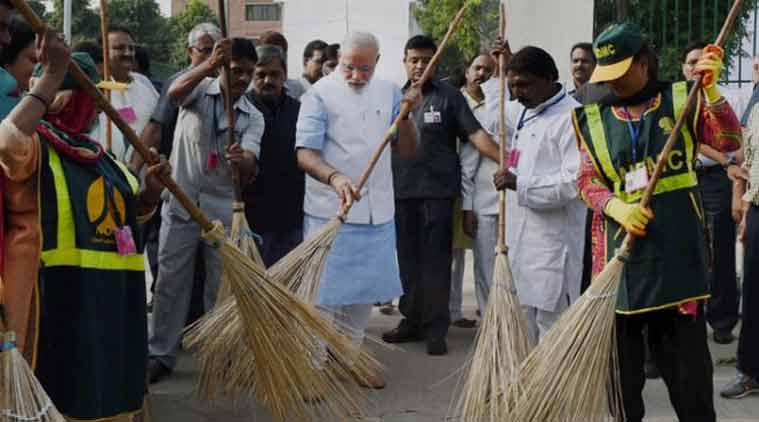- India
- International
Whose Campaign?
Swachh Bharat needs everyone to want a toilet and use it all the time.
 Narendra Modi wields a broom with NDMC workers to launch ‘Swachh Bharat Abhiyan’. (Source: PTI/file photo)
Narendra Modi wields a broom with NDMC workers to launch ‘Swachh Bharat Abhiyan’. (Source: PTI/file photo)
How can rural sanitation really take off? The stories of missing and badly constructed toilets, of toilets not being used or used as stores, and some only being used by some in the family or some of the time, of people preferring open defecation and considering it healthier, are endless. Political priority, increased subsidy and dedicated efforts by senior officials have not unstuck the logjam. Nor have traditional messages about health. After one year of the Swachh Bharat Abhiyaan, four remain before the target year of 2019. Does something very different have to happen?
Why do people prefer open defecation and not want toilets or, if they have them, only use them some of the time? Recent research has shown two critical elements: ideas of purity and pollution, and not wanting pits or septic tanks to fill because then they have to be emptied. These are the elephants in the room. To achieve open defecation free conditions, they have to be confronted and transformed. People have to perceive toilet use and pit-emptying as clean and not polluting.
On a recent visit to a periurban village in UP, I found that cheaper hygienic twin pit toilets, which turn waste into fertiliser, had been largely replaced with more expensive septic tanks. Some septic tanks were unhygienic, seeping into standing water. We were shown one of the few remaining twin pit toilets. I scooped out some of the fertiliser with my hand: It was odourless, crumbly and pleasant to feel. And, of course, valuable.
Then we went to a village chosen at random. Entering the village, a small boy was dropping a large turd on the roadside. The image sticks in my mind. The village had 150 households and an estimated 300 mobile phones. The houses were pucca. The few toilets were all with septic tanks, which people had built at their own expense. None was being used by all members of the household all the time. The government had constructed 35 toilets, but badly and incompletely. The superstructures had been dismantled or were being used as stores. Not one was in use as a toilet. The villagers asked why we had chosen their village to come to when the entire block and district were the same.
From these visits, and from recent research, what is there to learn? Collective behaviour change, as in the Swachh Bharat guidelines, is the only way forward. For that, social norms have to change. Everyone must want a toilet and want to use it all the time, just as they want mobile phones and want to use them all the time. Everyone must expect others to do the same and disapprove of them if they practise open defecation, and know that this is how they too are expected to behave.

How could such a radical, convulsive switch be brought about? And widely? A precondition is inspired and committed leadership, as well as champions and sustained campaigns in which all citizens and organisations are engaged so no one can hide and all are assaulted again and again by the same demonstrations, examples and information. If anything is to shift, these have to be dramatic and brutal.
I propose two major thrusts. The first is to focus on pit-emptying, encouraging entrepreneurs and a market, as in Bangladesh, for pits of all sorts. Where twin pits, with their advantages over septic tanks, are standard, let leadership be dramatic. Politicians, spiritual leaders, officials and many others can be challenged to take out the contents of mature, safe pits and display and handle them in public meetings, showing that they are not polluting. Then people should not fear having to empty their pits.
The second thrust is brutal: In meetings, posters, and all media, affirming that “shit stunts”. Open defecation accounts for over half of undernutrition, measured as stunting. Open defecation and population density together account for two-thirds of stunting. This applies to much of rural India. Stunting means impaired cognitive development, less schooling, poorer performance in school, less earned later in life, vulnerability to disease through damaged immune systems and even obesity. So be brutal in pinning responsibility on those who defecate in the open.
The writer is research associate, the Institute of Development Studies, University of Sussex, UK.
40 Years Ago
EXPRESS OPINION
More Explained
Apr 16: Latest News
- 01
- 02
- 03
- 04
- 05









































